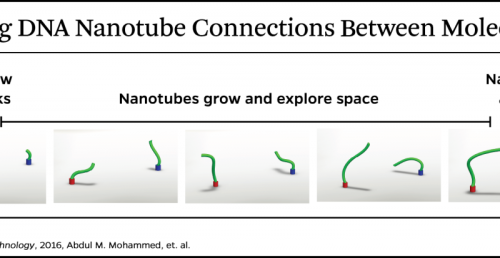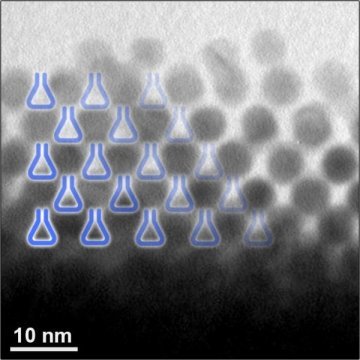#self assembly
Captured on video: DNA nanotubes build a bridge between two molecular posts
In a microscopic feat that resembled a high-wire circus act, Johns Hopkins researchers have coaxed DNA nanotubes to assemble themselves into bridge-like structures arched between two molecular landmarks on the surface of a lab dish.
The team captured examples of this unusual nanoscale performance on video.
This self-assembling bridge process, which may someday be used to connect electronic medical devices to living cells, was reported by the team recently in the journal Nature Nanotechnology.
To describe this process, senior author Rebecca Schulman, an assistant professor of chemical and biomolecular engineering in the university’s Whiting School of Engineering, referred to a death-defying stunt shown in the movie “Man on Wire.” The film depicted Philippe Petit’s 1974 high-wire walk between the World Trade Center’s Twin Towers.
Schulman pointed out that the real-life crossing could not have been accomplished without a critical piece of old-fashioned engineering: Petit’s hidden partner used a bow and arrow to launch the wire across the chasm between the towers, allowing it to be secured to each structure.
Post link
Tiny ‘flasks’ speed up chemical reactions
Self-assembling nanosphere clusters may improve everything from drug synthesis to drug delivery
Miniature self-assembling “flasks” created at the Weizmann Institute may prove a useful tool in research and industry. The nanoflasks, which have a span of several nanometers, or millionths of a millimeter, can accelerate chemical reactions for research. In the future, they might facilitate the manufacture of various industrial materials and perhaps even serve as vehicles for drug delivery.
Dr. Rafal Klajn of the Weizmann Institute’s Organic Chemistry Department and his team were originally studying the light-induced self-assembly of nanoparticles. They were employing a method earlier developed by Klajn in which inorganic nanoparticles are coated in a single layer of organic molecules that change their configuration when exposed to light; these alter the properties of the nanoparticles such that they self-assemble into crystalline clusters. When spherical nanoparticles of gold or other materials self-assembled into a cluster, empty spaces formed between them, like those between oranges packed in a case. Klajn and his team members realized that the empty spaces sometimes trapped water molecules, which led them to suggest that they could also trap “guest” molecules of other materials and function as tiny flasks for chemical reactions. A cluster of a million nanoparticles would contain a million such nanoflasks.
As reported in Nature Nanotechnology, when the scientists trapped molecules that tend to react with one another inside the nanoflasks, they found that the chemical reaction ran a hundred times faster than the same reaction taking place in solution. Being confined inside the nanoflasks greatly increased the concentration of the molecules and organized them in a way that caused them to react more readily. Enzymes speed up chemical reactions in a similar manner – by confining the reacting molecules within a pocket.
Post link
SELF-ASSEMBLY
All of these mircoscopic structures are made of the same material, diphenylalanine (FF). Researchers are learning to direct the formation of these self-assembled patterns and morphologies by carefully controlling the evaporation of solvent from solutions of FF. Despite their vastly different appearances, the products in each image are alike in their chemical composition and crystalline lattice. The team varied how solvent evaporated while forming these structures by controlling humidity, heat, solvent choice, and other factors. The team hopes that such exquisite control of the FF physical properties will make it useful in many applications, including energy devices, biosensors, catalysts, and photonics.
Credit:ACS Nano 2015, DOI: 10.1021/acsnano.5b05936
Post link
Reversible Writing with Light
Self-assembling nanoparticles take their cues from their surroundings
The medium is the message. Dr. Rafal Klajn of the Weizmann Institute’s Organic Chemistry Department and his group have given new meaning to this maxim: An innovative method they have now demonstrated for getting nanoparticles to self-assemble focuses on the medium in which the particles are suspended; these assemblies can be used, among other things, for reversibly writing information.
This approach is an elegant alternative to present methods that require nanoparticles to be coated with light-sensitive molecules; these then switch the particles’ state when light is shined on them. According to the group’s research, which recently appeared in Nature Chemistry, putting regular, uncoated nanoparticles into a light-sensitive medium would be simpler, and the resulting system more efficient and durable than existing ones. The possible applications range from rewritable paper, to water decontamination, to the controlled delivery of drugs or other substances.
The medium, in this case, is made up of small “photo-switchable” (or “photoresponsive”) molecules called spiropyrans. In the version of the photoresponsive molecule employed by Klajn and his group, absorbing light switches the molecule to a form that is more acidic. The nanoparticles then react to the change in acidity in their environment: It is this reaction that causes the particles to aggregate in the dark and disperse in the light. This means that any nanoparticles that respond to acid – a much larger group than those that respond to light – can now potentially be manipulated into self-assembly.
Post link
Researchers have developed a new method for growing ‘hybrid’ crystals at the nanoscale, in which quantum dots – essentially nanoscale semiconductors – of different materials can be sequentially incorporated into a host nanowire with perfect junctions between the components. Images recorded in …
Researchers create self-assembled logic circuits from proteins
In a proof-of-concept study, researchers have created self-assembled, protein-based circuits that can perform simple logic functions. The work demonstrates that it is possible to create stable digital circuits that take advantage of an electron’s properties at quantum scales.
One of the stumbling blocks in creating molecular circuits is that as the circuit size decreases the circuits become unreliable. This is because the electrons needed to create current behave like waves, not particles, at the quantum scale. For example, on a circuit with two wires that are one nanometer apart, the electron can “tunnel” between the two wires and effectively be in both places simultaneously, making it difficult to control the direction of the current. Molecular circuits can mitigate these problems, but single-molecule junctions are short-lived or low-yielding due to challenges associated with fabricating electrodes at that scale.
“Our goal was to try and create a molecular circuit that uses tunneling to our advantage, rather than fighting against it,” says Ryan Chiechi, associate professor of chemistry at North Carolina State University and co-corresponding author of a paper describing the work.
Post link






